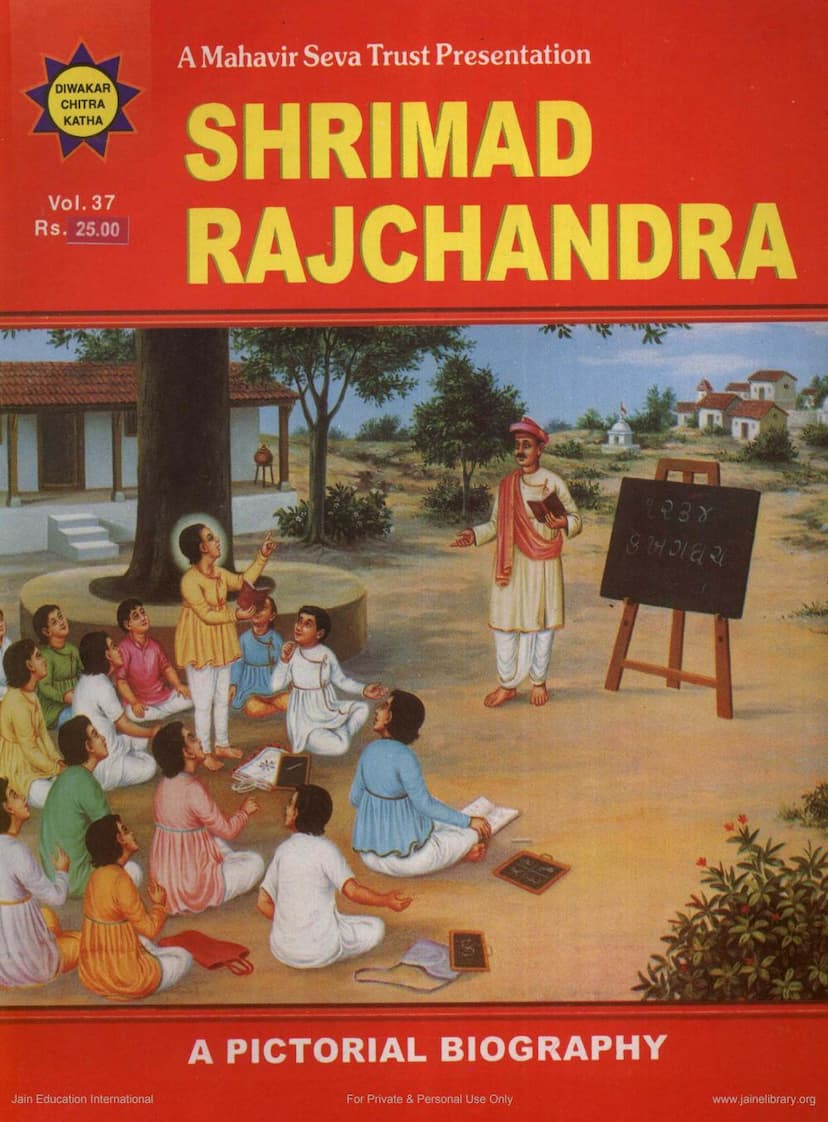Shrimad Rajchandra Diwakar Chitrakatha 037
Added to library: September 2, 2025
Loading image...

Summary
This document is a pictorial biography of Shrimad Rajchandra, a prominent Jain spiritual leader, poet, and scholar. It traces his life from birth to his mahasamadhi (conscious departure from the body).
Key aspects of Shrimad Rajchandra's life as depicted in the text:
- Early Life and Prodigious Intellect: Born on November 11, 1867, in Vavania, Saurashtra, to a Vaishnava father and Jain mother, Rajchandra (later Shrimad Rajchandra) displayed extraordinary intelligence and memory from a young age. He was known for his quick learning, poetic gifts, and remarkable memory, even teaching his teachers. He also experienced "Jati Smarana Gnana" (knowledge of past lives) at a young age.
- Spiritual Inclination and Vairagya: Even as a child, he showed signs of vairagya (non-attachment to worldly possessions) and had a deep desire for spiritual pursuits, alongside his intellectual development.
- Literary and Intellectual Prowess:
- By age eleven, he was writing for publications.
- At sixteen, he composed "Mokshamala," a foundational Jain text explaining the philosophy in a simple primer format.
- He mastered the art of "ashtavadhanas" and later "shatavadhana" (performing and remembering multiple tasks simultaneously), astonishing audiences with his mnemonic abilities and linguistic skills.
- He developed a deep understanding of various scriptures, including Jain, Vedanta, and Upanishads, through self-study.
- His most significant literary work, "Shri Atma-Siddhi Shastra," written in simple Gujarati in a dialogue format, is considered a jewel of Jain spiritual literature.
- Influence on Mahatma Gandhi: Shrimad Rajchandra had a profound impact on Mohandas Karamchand Gandhi. Their exchange of letters and Gandhi's admiration for Rajchandra's intellect and moral earnestness were instrumental in shaping Gandhi's spiritual journey. Shrimad's guidance helped Gandhi resolve his religious doubts.
- Business Acumen and Honesty: He entered business in Bombay and was remarkably successful. He was known for his scrupulous honesty, fore-sighted advice, and compassion, even forgoing profits in business deals to uphold ethical principles.
- Spiritual Realization and Renunciation: From 1886 onwards, he experienced intense vairagya and sought renunciation. In 1891, he achieved "Shuddh-Samkit" (pure equanimity or self-realization) and "Para-Bhakti" (oneness with God). He eventually retired from active business to dedicate himself fully to spiritual pursuits.
- Teachings and Legacy: His teachings emphasized the six basic tenets of the soul, the importance of right knowledge, perception, and conduct (Samyak Gnana, Darshan, and Charitra), and the path to salvation (Moksha). He was revered by many, including Jain monks and lay followers, who recognized his divinity and sought his guidance.
- Mahasamadhi: Shrimad Rajchandra passed away on April 9, 1901, at the age of thirty-four, in a state of conscious departure known as Mahasamadhi. His life exemplified spiritual attainment, intellectual brilliance, and profound ethical conduct.
- Disciples and Followers: Key figures like Shri Laghuraj Swami (Prabhushri) and Shri Sobhagbhai were deeply devoted to Shrimad Rajchandra and carried forward his teachings, establishing the Shrimad Rajchandra Ashram.
The book is presented as a "Diwakar Chitrakatha," meaning it uses illustrations to narrate the life story in an engaging and accessible manner. The publishers, Mahavir Seva Trust Mumbai and Federation of Jain Associations in North America (JAINA), aim to spread Jain literature and philosophy.